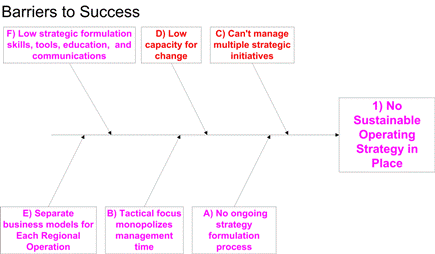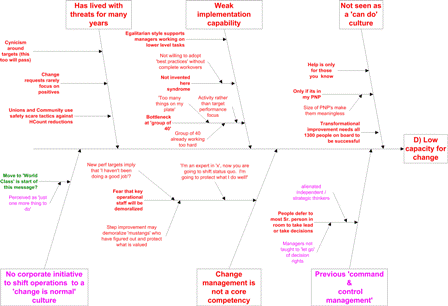The University of Michigan, surveyed 308 executives during 2005 on the variables that were most likely to derail their strategy. The variable chosen most frequently, by 38% of the respondents was, was “their Company’s Past / Habits”. That seems to suggest either an unwillingness or lack of a capability to address these habits. In many organizations these are also called the sacred cows or “the elephant in the room that no one wants to talk about’’.
Jim Collins has it right in his best seller “Good to Great”. One of the most important habits for a great company is to “Face the Brutal Facts”. One set of facts that few mature organizations face is the entrenched habits that hold them back from high achievement.
It is absolutely possible to change deeply entrenched organizational habits.  I worked with a business unit of a large firm that needed to address this issue head-on. They were given five years to achieve a production target well above their historic ability, or risk being sold. They desperately needed to depart from their past, from the habits that had held them back.
I worked with a business unit of a large firm that needed to address this issue head-on. They were given five years to achieve a production target well above their historic ability, or risk being sold. They desperately needed to depart from their past, from the habits that had held them back.
They were going to need everyone’s maximum effort to achieve the target. That meant ensuring that everyone was on the same page, committed to the same objectives. We decided to identify to the whole management team what we believed were the problem habits and how they were directly linked to achieving the targeted outcomes. We then showed the actions we wanted people in the organization to take. In many cases this meant changes to deeply rooted leadership practices. The top leadership team had to lead by example. The process gave license to all of the team to ‘correct’ their peers when they were using behaviors that propped up the old habits.
They also embraced a reporting mechanism that would provide the full organization with visibility on progress. It showed that the leadership was serious about change.
The result was a great success. It was especially rewarding to hear the team formally declare when any of the ‘bad’ habits was sufficiently eliminated. It was then removed as a risk to success on the execution roadmap.

The method can work for any sized organization. To achieve the same result here are seven steps to follow;
- Identify the habits you’d like to change (free flowing interviews using a trusted third-party works best),
- Identify the root cause of the habits (to ensure you don’t just end up hiding the symptoms),
- Put in place outcomes and associated initiatives to remove the cause of those habits.
- Structure a logical diagram to communicate the links between the main program’s targeted outcomes, the habits you want to remove and the root causes.
- Put in place a way to track change efforts on the root causes. A modified cause/effect diagram also known as a fishbone diagram works well.
- Start by coloring the text for all the identified ‘bad’ habits and route-causes in red. When you start working on improving any of them, change the appropriate text colors to orange. When you agree that the cause / or symptom is sufficiently removed, color the text in green. It should also allow you to identify reduction in the visible symptoms that the organization has for so long associated with those habits.
- This should provide a real sense of accomplishment. Celebrate successes. You should notice fewer grumblings about ‘we’ll never be able to get it done’. It shows the organization;
- you understand what the barriers are,
- that they are true impediments to success,
- that actions are in place and
- you recognize when there is real improvement.
Feel free to contact me if you’d like further information by using the comment link on this posting.




![Better Execution: Stick to Your Strategy? [Part 2]](https://www.strategy2execution.com/wp-content/uploads/2015/11/glacialstrategy3.jpg)

Leave A Comment